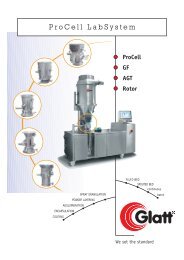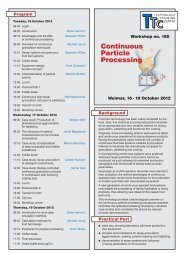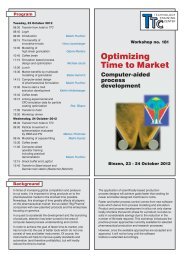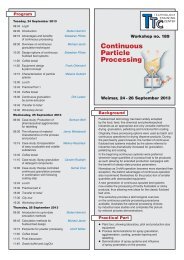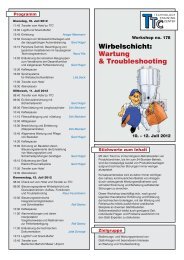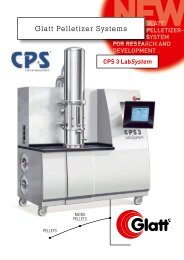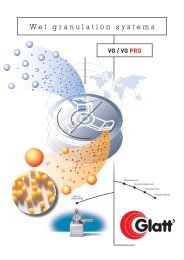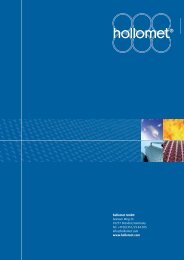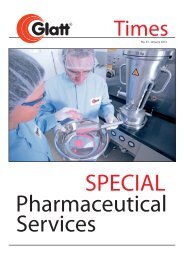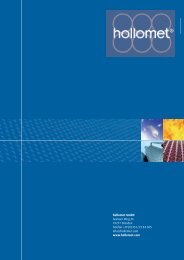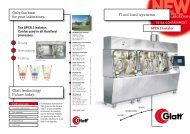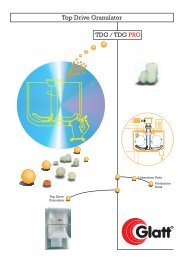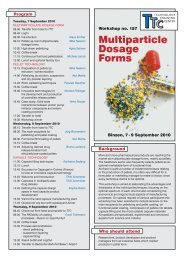You also want an ePaper? Increase the reach of your titles
YUMPU automatically turns print PDFs into web optimized ePapers that Google loves.
PAT Integration Into Process Automation<br />
Raw materials<br />
API’s<br />
Identification<br />
Humidity,<br />
Quantities<br />
Wet Granulation<br />
Oral Dosage Forms – typical process steps & their PAT application<br />
By Ralf Kretzschmar, <strong>Glatt</strong> Dresden, and Thomas Hofmaier, <strong>Glatt</strong> B<strong>in</strong>zen<br />
In recent years near-<strong>in</strong>frared spectroscopy, as well as other<br />
onl<strong>in</strong>e measurement systems (e.g. particle size or solid flows)<br />
have ga<strong>in</strong>ed grow<strong>in</strong>g <strong>in</strong>terest with<strong>in</strong> the pharmaceutical <strong>in</strong>dustry<br />
for both quality control and process monitor<strong>in</strong>g [1].<br />
In order to understand the process, one ma<strong>in</strong> key of the PAT <strong>in</strong>itiative,<br />
onl<strong>in</strong>e measurement is an important parameter for a successful<br />
PAT implementation. The second, with at least similar<br />
importance is the process<strong>in</strong>g of these measurement results to<br />
reliable rules for the process and f<strong>in</strong>ally the control of the process<br />
accord<strong>in</strong>gly.<br />
Typically these onl<strong>in</strong>e measurements not only generate one<br />
<strong>in</strong>gle signal – such as the product temperature PT100 probe - but<br />
generate a set of actual values <strong>in</strong> a “spectrum” which typically do<br />
need some sort of “multi parameter <strong>in</strong>terpretation” to be able to<br />
generate some reliable algorithms for the f<strong>in</strong>al process control.<br />
GLATT has <strong>in</strong>tegrated these systems <strong>in</strong>to process automation<br />
solutions such as MegaView or EcoView.<br />
With an <strong>in</strong>creas<strong>in</strong>g number of projects, we have started to develop<br />
and ma<strong>in</strong>ta<strong>in</strong> standard <strong>in</strong>terface modules for these PAT applications<br />
– for example for solid flow measurements with<strong>in</strong> the<br />
Wurster tubes, particle size measurements with the PARSUM<br />
devices or for NIR/MW systems <strong>in</strong> various process applications.<br />
Besides our solutions customers worldwide are typically request<strong>in</strong>g<br />
their favorite sub-supplier to be <strong>in</strong>tegrated. We do recognize<br />
an <strong>in</strong>creas<strong>in</strong>g number of NIR or microwave system suppliers,<br />
each of them hav<strong>in</strong>g their strengths and weaknesses depend<strong>in</strong>g<br />
on the specific application and product. Therefore, we have not<br />
just focused on one system, but have rather added most of them<br />
<strong>in</strong>to our application library.<br />
For example NIR/MW:<br />
Pharmaceutical applications of near-<strong>in</strong>frared and/or Microwave<br />
spectroscopy present both chemical and physical <strong>in</strong>formation <strong>in</strong><br />
development or production. “Nowadays NIR/MW is used <strong>in</strong> both<br />
off and on-l<strong>in</strong>e applications <strong>in</strong> various pharmaceutical <strong>in</strong>dustrial<br />
process control applications.<br />
Cont<strong>in</strong>uous monitor<strong>in</strong>g of quality is essential for PAT. The power<br />
of NIRS for PAT is based on its speed and nondestructive nature,<br />
which allows the analysis of <strong>in</strong>tact dosage forms or <strong>in</strong>termediate<br />
forms (e.g. granules, pellets) for chemical and physical <strong>in</strong>formation<br />
[1]. Besides NIR you might see similar benefits <strong>in</strong> onl<strong>in</strong>e<br />
particle size measurements.<br />
Pellets<br />
Dry<strong>in</strong>g<br />
Granulation,<br />
Coat<strong>in</strong>g,<br />
Mill<strong>in</strong>g<br />
Humidity,<br />
Endpo<strong>in</strong>t of Wett<strong>in</strong>g and Dry<strong>in</strong>g,<br />
Pellet Agglomeration<br />
Particle Size Control<br />
Particle Size Distribution (Fluid Bed,<br />
Mill<strong>in</strong>g)<br />
Fluidization Control<br />
Monitor<strong>in</strong>g aga<strong>in</strong>st Reference Batch<br />
But how to implement them <strong>in</strong>to the process controls?<br />
Below, the 4 typical areas of <strong>in</strong>tegration:<br />
1. Automation of read<strong>in</strong>g cycles and management of clean<strong>in</strong>g<br />
cycles<br />
2. Systems setup<br />
3. Signal process<strong>in</strong>g and data <strong>in</strong>terpretation<br />
4. Implementation <strong>in</strong>to process control (trip po<strong>in</strong>ts, monitor<strong>in</strong>g<br />
and alarm<strong>in</strong>g)<br />
Ad 1. Clean<strong>in</strong>g of the sensor head is essential <strong>in</strong> most cases.<br />
This can either be achieved with liquid (the sensor is flushed <strong>in</strong><br />
cycles) or compressed air. Process automation manages the valves<br />
for the clean<strong>in</strong>g media and their clean<strong>in</strong>g cycles, and reactivates<br />
the measurement once the clean<strong>in</strong>g has been carried out.<br />
Very often these cycle parameters are product related, and therefore<br />
become part of the Megaview or EcoView recipe system.<br />
Ad 2. Typically the sensor works with a set of parameters def<strong>in</strong>ed<br />
dur<strong>in</strong>g setup/calibration of the system. In some cases these parameters<br />
for each product have to be def<strong>in</strong>ed <strong>in</strong>dividually and are<br />
stored and ma<strong>in</strong>ta<strong>in</strong>ed with<strong>in</strong> the sensor device. Here the setup<br />
of the system has to be triggered by the GLATT control system<br />
before start<strong>in</strong>g the batch. In these cases we download the actual<br />
Fig. 1: Monitor<strong>in</strong>g with NIR at a GLATT fluid bed<br />
Photo with courtesy from Sentronic GmbH<br />
Blend<strong>in</strong>g<br />
Compress<strong>in</strong>g<br />
Homogeneity Hardness,<br />
Compression<br />
Rate<br />
Coat<strong>in</strong>g<br />
Coat<strong>in</strong>g<br />
Thickness,<br />
Dissolution<br />
Profile<br />
International Times No. 27 · March 2009<br />
3



